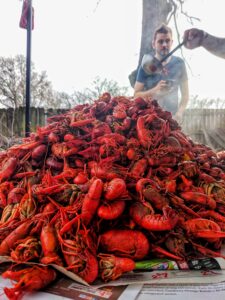Mudbug Envy
A shellfish allergy renders a food columnist wistful
Published: February 28, 2022
Last Updated: May 31, 2022

Photo by Lucie Monk Carter
This article must begin with a culinary confession. I am allergic to shellfish and have never tasted a crawfish. Allergies notwithstanding, I have long been fascinated by the roseate creatures that look for all the world like lobsters that have been hit with a shrinking ray. I’m not exactly sure when I was first aware of crawfish. Perhaps I’d glimpsed them atop a tower of shellfish heading out to a table at one of the Parisian brasseries that I love to frequent. Certainly, back in my days of traveling to Martinique and Guadeloupe, the most elegant of the appetizers offered at the fancier Creole restaurants was a buisson d’ecrévisses: literally a shrub of crawfish. Defined in 1903 by Auguste Escoffier and followed through by classic French chefs from Curnonsky to Bocuse, the dish was a pile of cooked crawfish that were either served mounded in a dome or arranged cascading off the sides of a large-stemmed serving vessel. They were poached with a variety of herbs and served cold. They would appear at neighboring tables amid much oh-ing and ah-ing only to be gobbled down accompanied by crystal glasses of chilled Sancerre.
When I arrived in New Orleans, my take on the small crustaceans became decidedly more inclusive in its approach. I thought less about Sancerre and more about longnecks and rowdiness, and the only Crystal on the table was hot sauce. My first awareness of crawfish in New Orleans was in a painting by my NOLA neighbor, the fine artist Simon Gunning. His rendition of a crawfish boil was notable because it featured several of them escaping from the pot and exiting the scene with, I imagined, as much speed as they could muster. I was amused and intrigued. Since then, I’ve attended very few crawfish boils because of my allergy, but it would be impossible to live in New Orleans in crawfish season without being aware of them.
I would learn that during crawfish season—and it is a season—television newscasters announce that the crop will be scarce or plentiful, and what to expect with prices; trucks parked on street corners sell them raw or already cooked, by the pound, with special discounts for what seem to be astounding amounts; hardware stores haul out their stock of burners—huge pots that they also sell for the frying of turkeys; and the city and indeed the southern portion of the state turn their thoughts to the celebrations of family and community that are crawfish boils. Their special place in my adopted city’s ongoing culinary history renewed my curiosity about crawfish.
…when I see one of the mudbugs cresting the top of the pot and heading for freedom, there’s always a part of me that is rooting for it.
I learned that crawfish are freshwater crustaceans. They are found in many parts of the world from Mississippi to Madagascar, with Asia producing 95 percent of the world’s crawfish supply. Crawfish are known by many names, and are called everything from mudbugs in the Mississippi Delta to crawdads in Oklahoma to yabbies in Australia—and of course, crayfish, a name never to be uttered in Louisiana. In North America, the largest diversity of species occurs in the southeastern United States. Here, they are, in the minds of most, linked with Louisiana, and they are the state’s official crustacean. (Louisiana is the only state that has one of those.) The Pelican State also takes primacy of production, sending a staggering 100 million pounds of them to market annually. The industry in Louisiana dates to precolonial days, when the bottom-dwelling crawfish were considered poor folks’ food and not the treat they are today. Nowadays, crawfish are commercially grown in flooded rice fields, a bi-crop that has become an industry.
While a seafood boil is certainly one of the most common ways that crawfish are served, they also turn up in étouffée, savory pies, and a multiplicity of soups, butters, pastas, and salads, with their use being limited only by the creativity of the chef. Chefs Aquanette “Ackie” Singleton and Keimika Melancon’s food trucks, which serve food at New Orleans second lines and social and pleasure club events, are noted for their crawfish tacos and crawfish sausages.
The removal of a crawfish’s shell reveals its digestive track, stark against the white tail meat. Online, questions abound about whether one should eat crawfish poop. Chef Paul Bocuse offers an interesting suggestion to those who are concerned: live crawfish can be “purged” by immersing them in a bath of cold milk for two hours. According to him, crawfish hate the taste of milk and will move around vigorously and purge themselves of all bitterness. And he seems to know his mudbugs, because he reminds folks to cover the vessel in which they are purging the crawfish with a grill, to keep them from escaping.
It’s that time of year again, and as we return to outdoor entertaining and socializing with friends, there will be a crawfish boil or two on my calendar. Perhaps it’s anti-social of me, but while my friends are pinching the tails and sucking the heads, when I see one of the mudbugs cresting the top of the pot and heading for freedom, there’s always a part of me that is rooting for it.
